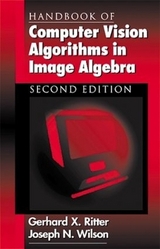
Handbook of Computer Vision Algorithms in Image Algebra
Crc Press Inc (Verlag)
978-0-8493-2636-3 (ISBN)
- Titel erscheint in neuer Auflage
- Artikel merken
Handbook of Computer Vision Algorithms in Image Algebra provides engineers, scientists, and students with an introduction to image algebra and presents detailed descriptions of over 80 fundamental computer vision techniques. These techniques represent a core of knowledge that all computer vision practitioners should have. The book also introduces the portable iac++ library, which supports image algebra programming in the C++ language.
Image algebra provides a concise, high-level mathematical language with which one can specify computer vision and image processing transformations and algorithms. It is clear, lucid, and easy to learn and use. Because of their high level of abstraction, image algebra specifications can be directly implemented on a variety of computer architectures. Programs using the iac++ library can be executed efficiently on both sequential and parallel computer architectures without modification. To aid practitioners in formulating algorithms in succinct and precise mathematical language, computer vision methods are presented with clear mathematical specifications. To assist algorithm implementors in developing robust programs, the practical impact of algorithm variants and implementation choices is discussed.
Image Algebra
Introduction
Point Sets
Value Sets
Images
Templates
Recursive Templates
Neighborhoods
The p-Product
Image Enhancement Techniques
Introduction
Averaging of Multiple Images
Local Averaging
Variable Local Averaging
Iterative Conditional Local Averaging
Max-Min Sharpening Transform
Smoothing Binary Images by Association
Median Filter
Unsharp Masking
Local Area Contrast Enhancing
Histogram Equalization
Histogram Modification
Lowpass Filtering
Highpass Filtering
Edge Detection and Boundary Finding Techniques
Introduction
Binary Image Boundaries
Edge Enhancement by Discrete Differencing
Roberts Edge Detector
Prewitt Edge Detector
Sobel Edge Detector
Wallis Logarithmic Edge Detection
Frei-Chen Edge and Line Detection
Kirsch Edge Detector
Directional Edge Detection
Product of the Difference of Averages
Crack Edge Detection
Local Edge Detection in Three Dimensional Images
Hierarchical Edge Detection
Edge Detection Using K-Forms
Hueckel Edge Operator
Divide-and-Conquer Boundary Detection
Edge Following as Dynamic Programming
Thresholding Techniques
Introduction
Global Thresholding
Semithresholding
Multilevel Thresholding
Variable Thresholding
Threshold Selection Using Mean and Standard Deviation
Threshold Selection by Maximizing Between Class Variance
Threshold Selection Using a Simple Image Statistic
Thinning and Skeletonizing
Introduction
Pavlidis Thinning Algorithm
Medial Axis Transform (MAT)
Distance Transforms
Zhang-Suen Skeletonizing
Zhang-Suen Transform - Modified to Preserve Homotopy
Thinning Edge Magnitude Images
Connected Component Algorithms
Introduction
Component Labeling for Binary Images
Labeling Components with Sequential Labels
Counting Connected Components by Shrinking
Pruning of Connected Components
Hole Filling
Morphological Transforms and Techniques
Introduction
Basic Morphological Operations: Boolean Dilations and Erosions
Opening and Closing
Salt and Pepper Noise Removal
The Hit-and-Miss Transform
Gray Value Dilations, Erosions, Openings, and Closings
The Rolling Ball Algorithm
Linear Image Transforms
Introduction
Fourier Transform
Centering the Fourier Transform
Fast Fourier Transform
Discrete Cosine Transform
Walsh Transform
The Haar Wavelet Transform
Daubechies Wavelet Transforms
Pattern Matching and Shape Detection
Introduction
Pattern Matching Using Correlation
Pattern Matching in the Frequency Domain
Rotation Invariant Pattern Matching
Rotation and Scale Invariant Pattern Matching
Line Detection Using the Hough Transform
Detecting Ellipses Using the Hough Transform
Generalized Hough Algorithm for Shape Detection
Image Features and Descriptors
Introduction
Area and Perimeter
Euler Number
Chain Code Extraction and Correlation
Region Adjacency
Inclusion Relation
Quadtree Extraction
Position, Orientation, and Symmetry
Region Description Using Moments
Histogram
Cumulative Histogram
Texture Descriptors: Gray Level Spatial Dependence Statistics
Neural Networks and Cellular Automata
Introduction
Hopfield Neural Network
Bidirectional Associative Memory (BAM)
Hamming Net
Single Layer Perceptron (SLP)
Multilayer Perceptron (MLP)
Cellular Automata and Life
Solving Mazes Using Cellular Automata
Appendix: The Image Algebra C++ Library
Index
| Erscheint lt. Verlag | 2.5.1996 |
|---|---|
| Zusatzinfo | 76 Halftones, black and white; 31 Tables, black and white |
| Verlagsort | Bosa Roca |
| Sprache | englisch |
| Maße | 178 x 254 mm |
| Gewicht | 1080 g |
| Einbandart | gebunden |
| Themenwelt | Mathematik / Informatik ► Informatik ► Programmiersprachen / -werkzeuge |
| Informatik ► Theorie / Studium ► Künstliche Intelligenz / Robotik | |
| ISBN-10 | 0-8493-2636-2 / 0849326362 |
| ISBN-13 | 978-0-8493-2636-3 / 9780849326363 |
| Zustand | Neuware |
| Haben Sie eine Frage zum Produkt? |
aus dem Bereich



